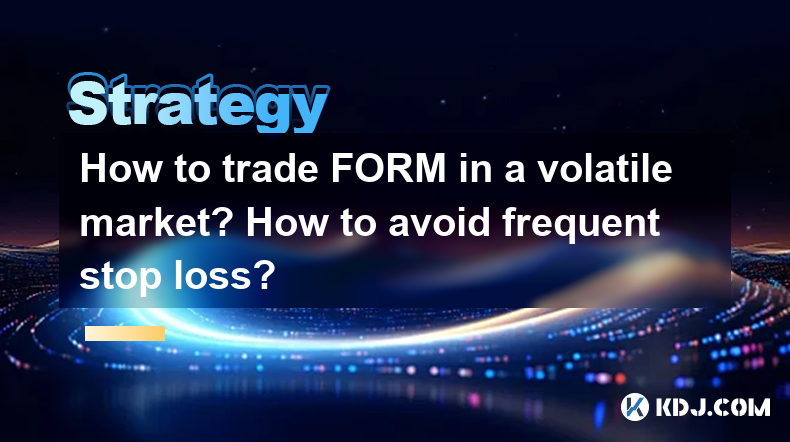-
 bitcoin
bitcoin $122025.899241 USD
-2.12% -
 ethereum
ethereum $4488.068729 USD
-4.11% -
 bnb
bnb $1315.348019 USD
8.65% -
 tether
tether $1.000457 USD
0.03% -
 xrp
xrp $2.875326 USD
-3.69% -
 solana
solana $222.043604 USD
-4.07% -
 usd-coin
usd-coin $0.999682 USD
0.00% -
 dogecoin
dogecoin $0.249887 USD
-5.62% -
 tron
tron $0.337379 USD
-2.59% -
 cardano
cardano $0.827763 USD
-5.06% -
 hyperliquid
hyperliquid $45.774531 USD
-2.43% -
 chainlink
chainlink $22.079309 USD
-5.87% -
 ethena-usde
ethena-usde $1.000156 USD
0.02% -
 sui
sui $3.482566 USD
-3.57% -
 stellar
stellar $0.386982 USD
-4.92%
How to trade FORM in a volatile market? How to avoid frequent stop loss?
To trade FORM effectively in a volatile market, use strategies like scalping, range trading, and breakout trading, and set wider or trailing stop losses to minimize frequent triggers.
May 05, 2025 at 08:02 pm

Trading FORM in a volatile market can be challenging, but with the right strategies, you can navigate these conditions more effectively. Volatility in the cryptocurrency market, especially for tokens like FORM, can lead to significant price swings that may trigger frequent stop losses. This article will explore various strategies to trade FORM in a volatile market and provide insights on how to minimize the occurrence of stop losses.
Understanding Volatility in the FORM Market
Volatility is a measure of the rate at which the price of a cryptocurrency increases or decreases for a given set of returns. For FORM, this can be influenced by various factors such as market sentiment, news events, and overall market trends. Understanding the causes of volatility can help traders anticipate potential price movements and adjust their strategies accordingly.
To trade FORM effectively in a volatile market, it's essential to stay informed about the latest developments that could impact its price. This includes monitoring news related to the FORM project, regulatory changes in the crypto space, and broader market trends. By keeping a close eye on these factors, you can better predict potential volatility and position your trades more strategically.
Strategies for Trading FORM in a Volatile Market
When trading FORM in a volatile market, several strategies can help you manage the risks and potentially capitalize on the price movements. Here are some effective approaches:
Scalping: This strategy involves making numerous small trades throughout the day to profit from small price changes. In a volatile market, scalping can be particularly effective as it allows traders to take advantage of rapid price movements. To scalp FORM, set tight stop losses and take-profit levels to ensure you can quickly exit trades and minimize potential losses.
Range Trading: In a volatile market, FORM may often trade within a specific price range. Identifying these ranges and trading within them can be profitable. To do this, look for support and resistance levels on the FORM chart. Buy near the support level and sell near the resistance level, adjusting your stop loss to protect your profits as the price moves in your favor.
Breakout Trading: This strategy involves entering a trade when the price of FORM breaks out of a defined range or pattern. In a volatile market, breakouts can be more frequent and significant. To trade breakouts, wait for the price to break above resistance or below support with increased volume, then enter the trade in the direction of the breakout. Set your stop loss just outside the breakout level to manage risk.
Setting Up Effective Stop Losses
To avoid frequent stop losses when trading FORM in a volatile market, it's crucial to set up your stop losses strategically. Here are some tips to help you do so:
Use Wider Stop Losses: In a volatile market, prices can fluctuate rapidly, often triggering stop losses. By setting wider stop losses, you give your trades more room to breathe and reduce the likelihood of being stopped out prematurely. However, be cautious not to set them too wide, as this can increase your potential losses.
Trailing Stop Losses: A trailing stop loss adjusts automatically as the price of FORM moves in your favor. This can help you lock in profits while still giving your trade room to grow. To set a trailing stop loss, choose a percentage or fixed amount that the stop loss will trail behind the current price. This way, if the price reverses, your stop loss will be triggered at a more favorable level.
Volatility-Based Stop Losses: Calculate your stop loss based on the current volatility of FORM. One common method is to use the Average True Range (ATR) indicator, which measures market volatility. Set your stop loss at a multiple of the ATR to account for the current market conditions. This approach helps you adapt your stop loss to the prevailing volatility, reducing the chance of being stopped out unnecessarily.
Technical Analysis Tools for Trading FORM
Technical analysis can be a powerful tool for trading FORM in a volatile market. By using various indicators and chart patterns, you can gain insights into potential price movements and make more informed trading decisions. Here are some key technical analysis tools to consider:
Moving Averages: These can help you identify the overall trend of FORM. Use a combination of short-term and long-term moving averages to spot potential entry and exit points. For example, when the short-term moving average crosses above the long-term moving average, it may signal a bullish trend, and vice versa for a bearish trend.
Relative Strength Index (RSI): The RSI is a momentum oscillator that measures the speed and change of price movements. It can help you identify overbought or oversold conditions in the FORM market. If the RSI is above 70, FORM may be overbought, suggesting a potential price correction. Conversely, if the RSI is below 30, FORM may be oversold, indicating a possible price rebound.
Bollinger Bands: These bands can help you gauge the volatility of FORM. When the bands widen, it indicates increased volatility, and when they narrow, it suggests decreased volatility. Trading opportunities may arise when the price of FORM touches the upper or lower band, signaling potential reversals or continuations.
Risk Management Techniques
Effective risk management is crucial when trading FORM in a volatile market. Here are some techniques to help you manage your risk and avoid frequent stop losses:
Position Sizing: Determine the size of your trades based on your overall trading capital and risk tolerance. A common rule of thumb is to risk no more than 1-2% of your trading capital on any single trade. This helps you manage your risk and avoid significant losses that could impact your ability to trade.
Diversification: Instead of putting all your capital into FORM, consider diversifying your portfolio across different cryptocurrencies. This can help spread your risk and reduce the impact of volatility in any single asset.
Emotional Discipline: Volatility can often lead to emotional trading decisions, such as chasing losses or exiting profitable trades too early. Maintain emotional discipline by sticking to your trading plan and avoiding impulsive decisions. Use tools like trading journals to track your performance and learn from your trades.
Frequently Asked Questions
Q: How can I identify when FORM is entering a volatile period?A: To identify when FORM is entering a volatile period, monitor the price movements and use technical indicators like the Average True Range (ATR) and Bollinger Bands. An increase in the ATR or widening of Bollinger Bands can signal rising volatility. Additionally, keep an eye on news and events that could impact FORM's price, as these can often trigger volatile market conditions.
Q: What are the best times of day to trade FORM in a volatile market?A: The best times to trade FORM in a volatile market can vary, but generally, the highest volatility occurs during the overlap of major market sessions, such as when the Asian and European markets are open simultaneously. This often happens between 2 AM and 4 AM UTC. Additionally, trading during major news releases or events related to FORM can also lead to increased volatility.
Q: How can I use fundamental analysis to complement my trading strategy for FORM?A: Fundamental analysis can complement your trading strategy for FORM by providing a deeper understanding of the project's value and potential. Look at factors such as the team behind FORM, their roadmap, partnerships, and overall market adoption. By combining this with technical analysis, you can make more informed trading decisions and better anticipate potential price movements.
Q: Is it better to trade FORM on a spot market or a futures market in a volatile environment?A: The choice between trading FORM on a spot market or a futures market in a volatile environment depends on your trading goals and risk tolerance. Spot markets allow you to buy and sell FORM directly, which can be less risky but may limit your ability to profit from short-term price movements. Futures markets, on the other hand, allow you to trade with leverage, which can amplify both gains and losses. If you're comfortable with higher risk and want to capitalize on short-term volatility, trading FORM futures might be more suitable.
Disclaimer:info@kdj.com
The information provided is not trading advice. kdj.com does not assume any responsibility for any investments made based on the information provided in this article. Cryptocurrencies are highly volatile and it is highly recommended that you invest with caution after thorough research!
If you believe that the content used on this website infringes your copyright, please contact us immediately (info@kdj.com) and we will delete it promptly.
- BlockDAG, DOGE, HYPE Sponsorship: Crypto Trends Shaping 2025
- 2025-10-01 00:25:13
- Deutsche Börse and Circle: A StableCoin Adoption Powerhouse in Europe
- 2025-10-01 00:25:13
- BlockDAG's Presale Buzz: Is It the Crypto to Watch in October 2025?
- 2025-10-01 00:30:13
- Bitcoin, Crypto, and IQ: When Genius Meets Digital Gold?
- 2025-10-01 00:30:13
- Stablecoins, American Innovation, and Wallet Tokens: The Next Frontier
- 2025-10-01 00:35:12
- NBU, Coins, and Crypto in Ukraine: A New Yorker's Take
- 2025-10-01 00:45:14
Related knowledge

Practical parameter settings for a Bitcoin multi-timeframe moving average system
Sep 18,2025 at 10:54pm
Optimizing Timeframe Combinations for Bitcoin Trading1. Selecting appropriate timeframes is crucial when building a multi-timeframe moving average sys...

How can I filter out false breakouts in Dogecoin high-frequency trading?
Sep 22,2025 at 01:00am
Understanding False Breakouts in Dogecoin Trading1. A false breakout occurs when Dogecoin's price appears to move beyond a defined support or resistan...

Techniques for identifying tops and bottoms in the Bitcoin on-chain NVT model
Sep 20,2025 at 07:54pm
Understanding the NVT Model in Bitcoin Analysis1. The Network Value to Transactions (NVT) ratio is often described as the 'P/E ratio' of the cryptocur...

What does the surge in open interest in Bitcoincoin futures mean?
Sep 20,2025 at 11:18pm
Understanding the Surge in Dogecoin Futures Open Interest1. A surge in open interest within Dogecoin futures indicates a growing number of active cont...

How can I use the Ethereum USDT premium to gauge market sentiment?
Sep 18,2025 at 11:55pm
Understanding the Ethereum USDT Premium1. The Ethereum USDT premium refers to the price difference between USDT (Tether) traded on Ethereum-based plat...

What should I do if Ethereum staking yields decline?
Sep 20,2025 at 06:18am
Understanding the Causes Behind Declining Ethereum Staking Yields1. The Ethereum network transitioned to a proof-of-stake consensus mechanism with the...

Practical parameter settings for a Bitcoin multi-timeframe moving average system
Sep 18,2025 at 10:54pm
Optimizing Timeframe Combinations for Bitcoin Trading1. Selecting appropriate timeframes is crucial when building a multi-timeframe moving average sys...

How can I filter out false breakouts in Dogecoin high-frequency trading?
Sep 22,2025 at 01:00am
Understanding False Breakouts in Dogecoin Trading1. A false breakout occurs when Dogecoin's price appears to move beyond a defined support or resistan...

Techniques for identifying tops and bottoms in the Bitcoin on-chain NVT model
Sep 20,2025 at 07:54pm
Understanding the NVT Model in Bitcoin Analysis1. The Network Value to Transactions (NVT) ratio is often described as the 'P/E ratio' of the cryptocur...

What does the surge in open interest in Bitcoincoin futures mean?
Sep 20,2025 at 11:18pm
Understanding the Surge in Dogecoin Futures Open Interest1. A surge in open interest within Dogecoin futures indicates a growing number of active cont...

How can I use the Ethereum USDT premium to gauge market sentiment?
Sep 18,2025 at 11:55pm
Understanding the Ethereum USDT Premium1. The Ethereum USDT premium refers to the price difference between USDT (Tether) traded on Ethereum-based plat...

What should I do if Ethereum staking yields decline?
Sep 20,2025 at 06:18am
Understanding the Causes Behind Declining Ethereum Staking Yields1. The Ethereum network transitioned to a proof-of-stake consensus mechanism with the...
See all articles










































































